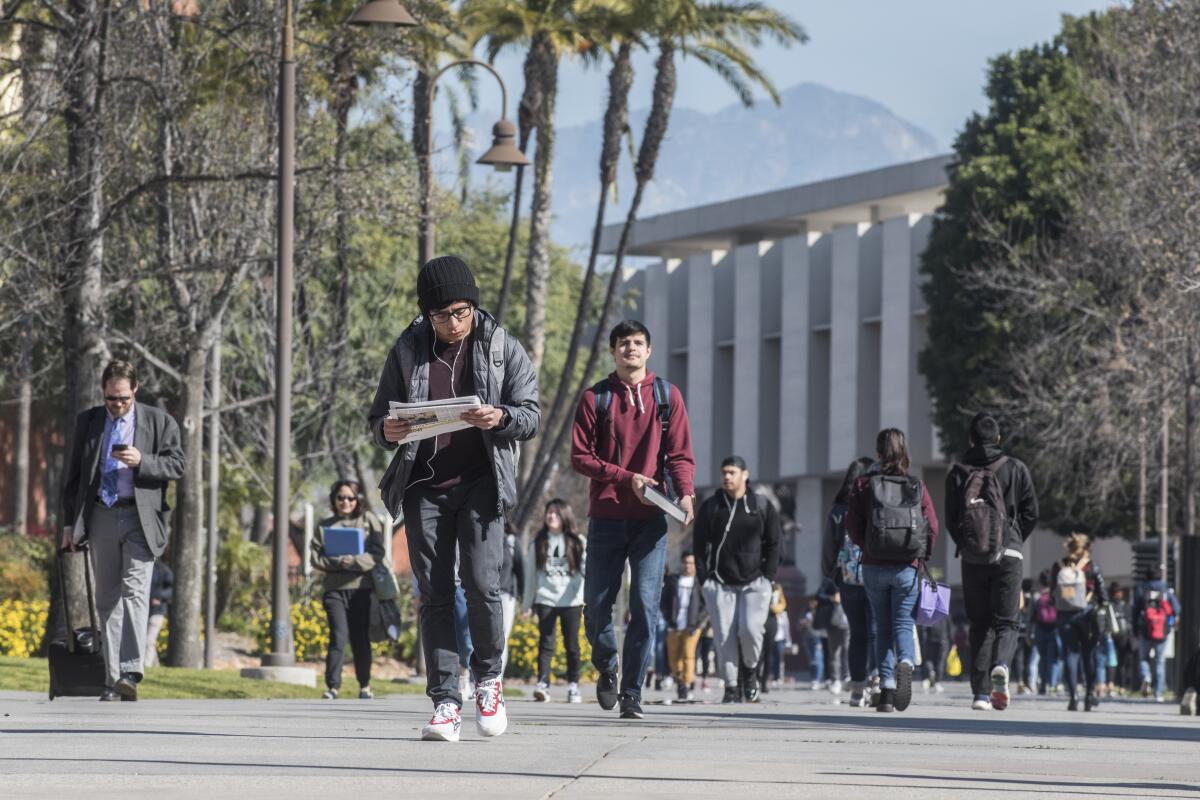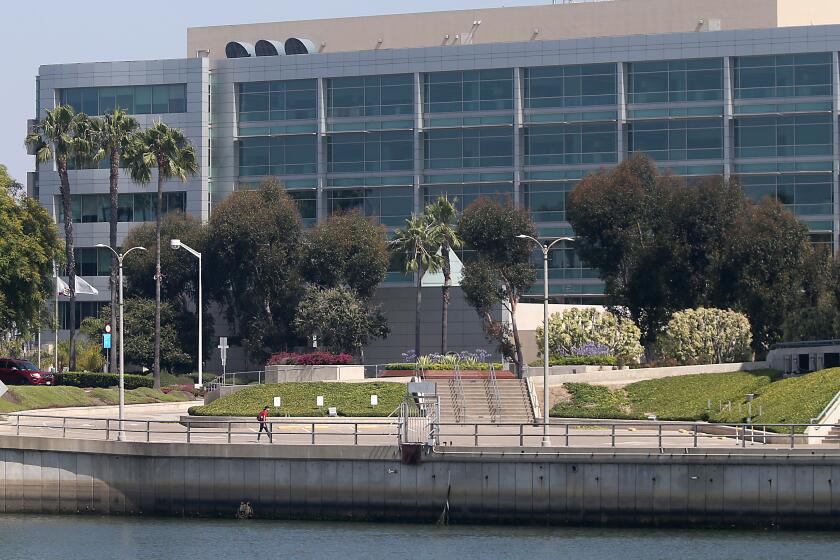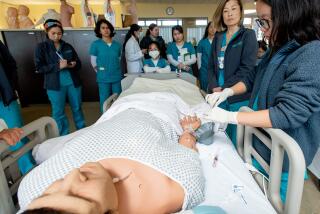CSU to shift the endgame for student success: A good job and a four-year degree

For decades, the California State University system focused on graduation rates as the top marker of student success, in line with most of its fellow higher education institutions.
But CSU â often called âthe Peopleâs Universityâ â is poised for a major reset as it changes its ultimate goalpost from a four-year degree to a good job. As more students and families question the value of a college pedigree, the nationâs largest four-year university system plans to boost efforts to link higher education with clear employment payoffs, offering more intentional advising on how to choose a career path of interest, select the right major for it and network with alumni and others to help land related internships and jobs.
âWe have to show students whatâs the endgame,â CSU Chancellor Mildred GarcĂa said in an interview this week. âItâs not graduation. Itâs how do we connect graduation to either a career that theyâre studying or graduate school and help them get to that? Thatâs what families want, right? Return on investment.â
GarcĂa said the changing nature of the systemâs 460,000 students â 54% of them Latino, Black, American Indian and Alaska Native, historically underrepresented groups â requires the 23 campuses to be more intentional about career guidance. Many students, especially those who are the first in their families to attend college, may not have the social connections to build resumes enhanced by internships, summer fellowships and other experiences that help launch careers after graduation, she said.
GarcĂa spoke about the pivot as CSU released new data Tuesday on progress toward its 10-year goal to increase graduation rates for all students and eliminate racial and ethnic achievement gaps. The findings â which show the system falling short in some areas despite improvements in others â are being discussed this week at a three-day CSU symposium on the Graduation 2025 initiative and the shift toward an expanded view of student success.
These college majors will lead to jobs that pay off your educational costs most quickly -- and lower-cost California State University and community colleges offer many of them.
Will CSU meet graduation rate goals?
The initiative set out to increase four-year graduation rates for first-time students from 19% in 2015 to 40% in 2025 and six-year rates from 57% to 70% during that same period. For transfer students, the goal is raising two-year graduation rates from 31% to 45% between 2015 and 2025 and four-year rates from 73% to 85% during that same period.
The new 2023-24 data show uneven progress and raises questions as to whether CSU can hit the end target next year. Four-year graduation rates for first-time students rose to 36.1% from 35% last year, 3.9% short of the goal. Six-year rates stayed steady at 62%, 8% short of the goal.
For transfer students, two-year rates increased to 44.2% from 41% last year, less than a percentage point short. Four-year graduation rates for transfer students are struggling, and fell to 75.6% from 79% last year.
California State University must implement recommendations from a 2023 state audit under the new law.
The proportion of students who dropped out has remained stagnant at 30%, CSU reported.
Other data showed that equity gaps have increased over the last decade. The difference in six-year graduation rates between historically underrepresented students of Latino, Black, American Indian and Alaska Native descent and students of other backgrounds was about 13 percentage points in 2023-24, compared with 11.6 points in 2014-15.
The gap between low-income students who receive federal Pell grants and those who do not also widened â to 11.3 percentage points from 8.8 points during that same period.
The data showed, however, that todayâs CSU students are different than those a decade ago. Low-income, first-generation and historically underserved students have increased by 50% â from 31,404 to 47,176 â from the entering classes of 2009 to 2019.
At the symposium, Garcia and others challenged campus leaders to find out which students are leaving and why, and craft effective ways to stem the loss. Students who stayed enrolled beyond their first year showed striking differences: 71% of all students persisted to the third year. But only 61% of Latino male first-generation students reached the three-year mark.
âThank God we are making progress ... but we still have a lot of work to do,â GarcĂa said. âI think we have to be honest that this ... doesnât happen overnight, and we have to do everything we can to get our students to get to the finish line.â
Pandemic, inflation a blow to students
Dilcie Perez, CSU deputy vice chancellor for academic and student affairs, said she remained optimistic that more progress can be made by next year. The pandemic was a key barrier to greater success, she said, forcing some students to leave school for health reasons, family responsibilities and financial difficulties. Those challenges have remained for some students, as inflation has boosted living costs and hit family budgets, she said.
Even so, the data show some bright spots, including a near doubling of the four-year graduation rates for first-time students since 2015.
Perez said some campuses have started âearly supportâ programs, monitoring the grades and attendance of students to intervene with help for those who begin showing signs of struggle. Another program, Second Start, involves outreach to those who have dropped out to help them restart their studies.
Cal State Los Angeles, for instance, has started using Graduate365, a new tool that helps the campus identify first-year students who did not reenroll, enabling outreach efforts to them. Cal State Monterey Bay is engaging students through a new program with Pebble Beach Co. that provides opportunities to study and work in the hospitality industry while earning money and credits toward their degrees and a full-time job upon graduation.
âI still think we have an opportunity to make a difference,â Perez said.
As the 10-year graduation initiative nears its end, CSU has launched an unprecedented outreach effort to survey more than 1 million faculty, staff, students, alumni and others on how to reimagine student success. University officials are poring over the data gathered and holding sessions with participants to begin crafting the new direction.
Questioning the value of college
GarcĂa â who previously served as president of Cal State Dominguez Hills and Cal State Fullerton â said she wanted to focus on post-graduate career success. She said she witnessed growing skepticism about the value of a college degree nationwide while serving as president of the 350-member American Assn. of State Colleges and Universities in Washington, D.C., before returning last fall to take the CSU helm and believed it should be addressed â especially for the universityâs first-generation and underrepresented students who may come in with âlimited knowledgeâ of the vast careers available to them.
About 30% of CSU students are first-generation. And nearly 50% are Latino â a huge shift from the 24% in 2007, when GarcĂa stepped in to head the Dominguez Hills campus.
Suzette Morales, a Cal State Fullerton fourth-year student majoring in business and sociology, said more career guidance is crucial for students such as her.
The daughter of Guatemalan immigrants with elementary school educations, Morales said she had no idea what an internship was or how to get one until a friend mentioned it in her second or third year of college. Despite early interest in law school, she did not know about the requirement for a law school exam or how to pay for it, causing her to put that goal on hold for now while she finishes school and serves in the U.S. Coast Guard.
âI had no experience with corporate jobs and no one to talk to about it,â Morales said.
Although the work to more intentionally link higher education and post-graduate jobs is just beginning, GarcĂa said it is crucial for not only students but also for cities, the state and nation, which will need the health professionals, teachers, businesspeople and other educated workers to keep the economy vital and strong.
âWe have the talent,â GarcĂa said. âWe have to make sure that we understand that public higher education is an investment.â
More to Read
Sign up for Essential California
The most important California stories and recommendations in your inbox every morning.
You may occasionally receive promotional content from the Los Angeles Times.













![[20060326 (LA/A20) -- STATING THE CASE: Marchers organized by unions, religious organizations and immigrants rights groups carry signs and chant in downtown L.A. "People are really upset that all the work they do, everything that they give to this nation, is ignored," said Angelica Salas of the Coalition of Humane Immigrant Rights. -- PHOTOGRAPHER: Photographs by Gina Ferazzi The Los Angeles Times] *** [Ferazzi, Gina -- - 109170.ME.0325.rights.12.GMF- Gina Ferazzi/Los Angeles Times - Thousands of protesters march to city hall in downtown Los Angeles Saturday, March 25, 2006. They are protesting against House-passed HR 4437, an anti-immigration bill that opponents say will criminalize millions of immigrant families and anyone who comes into contact with them.]](https://ca-times.brightspotcdn.com/dims4/default/34f403d/2147483647/strip/true/crop/1983x1322+109+0/resize/840x560!/quality/75/?url=https%3A%2F%2Fcalifornia-times-brightspot.s3.amazonaws.com%2Fzbk%2Fdamlat_images%2FLA%2FLA_PHOTO_ARCHIVE%2FSDOCS%2854%29%2Fkx3lslnc.JPG)